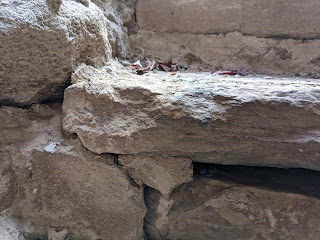“Here’s the original photograph of an
interesting image of a so-called “New England Colonial Stone Wall” that one
often sees while searching images online,” Dr. Johnnie Possum remarked to his associate Sherlock Stones. Possum read
the caption below the photo on the screen aloud: “Many of New England’s stone
walls, like this one in New Hampshire, are going back to nature as they fall
into disrepair and become overgrown with moss.”
Stones sighed
and put down his violin, peered at the screen for a moment. “Possum, we see and
yet fail to observe.” He turned to his Rocket Surgeon, as well as his consulting fellow Independent
Ceremonial Stone Landscape researcher friend, and asked, “Exactly which stones
are we to believe are “fallen stones” in this photograph?”
Possum pointed
to the center of the image, to the three stones on the ground. “Here of course!
Indicative of perhaps a tree fall long ago, perhaps - or a place where deer
have crossed the stone barrier, moving from one enclosure to another.”
Stones replied, “These three stones appear to be stacked in that spot rather than reposing as they fell. I would suspect a human has placed them so – although one may want to consider a tidy bear has moved them, in search of picnic baskets perhaps.” Possum chuckled at the reference to a talking cartoon bear as Sherlock Stones continued: “The same possible bear also appears to carry a can of red spray paint. Observe the red dot on the boulder at the breach. One might conclude that this spot is on a trail marked with red paint – or less likely, that it is an indicator of underground power lines that a land surveyor has noted.” Stones shook his head, as if chastising himself for entertaining the thought. “Perhaps it’s orange, the color for Communication lines,” he said, shaking his head again. He turned to Possum and said, “Despite what the author of the caption is telling us, before our eyes is a remarkably intact segment of artistically stacked stones. Some of the stones do display quite a good deal of moss and lichen growth, but “overgrown with moss” is not exactly how I for one would describe them.”
Scrolling down, Stones read aloud, “Why are there stone walls in New England? New England’s first farmers of European descent found themselves plowing soil strewn with rocks left behind by glaciers. So, stone by stone, they stacked the rocks into waist-high walls. Some say these walls helped win the American Revolution, and they later inspired Robert Frost’s poem “Mending Wall.” He turned to Doctor Possum and said, “Here’s a familiar tune! I thought this sounded very familiar!”
Both men read aloud the next sentence, “Host
Stevie Cordwood goes for a walk in the woods of New Hampshire with stone wall
expert Thorbert Roberson, the author of Rock
by Rock: The Magnificent True Life Colonizer History of New England’s Stone
Walls.”
“We know
this fellow's works quite well,” Possum remarked.
Stones
sighed, “Yes, we do, Possum, yes we do. So does the general public. We are quite familiar with his rigid stance
on the subject: "No humans intelligent enough to be building in stone until lost
settler-colonists accidently bumped into a rock around 1620 or thereabouts in
this part of the big blue world.”
“It’s really
quite a shame that the man remains willfully unaware of Indigenous Cultures in
the hemisphere,” Possum mused, ”There are remarkable stone, earth and even
shell Indigenous structures to be found everywhere. Those remarkable features in Pennsylvania,
some 2500 years old according to recent Optically Stimulated Luminescence
testing, come to mind.”
Sherlock Stones
was already at the keyboard of Dr. Possum’s laptop, plugging phrases into a
search engine, humming an old familiar song. "Let us see if more images of this remarkably intact, delicate looking stone structure will pop up..."
To be continued, perhaps...
























































